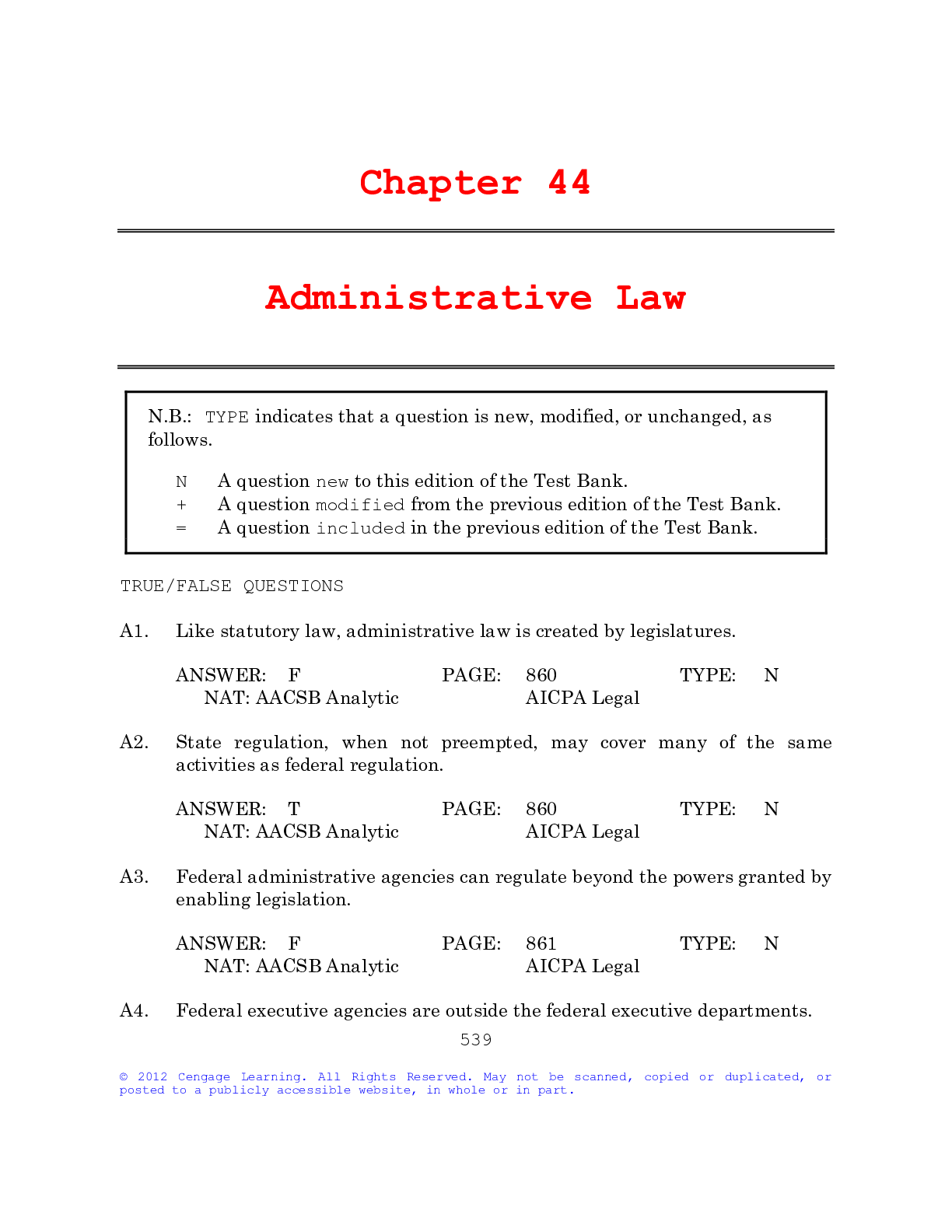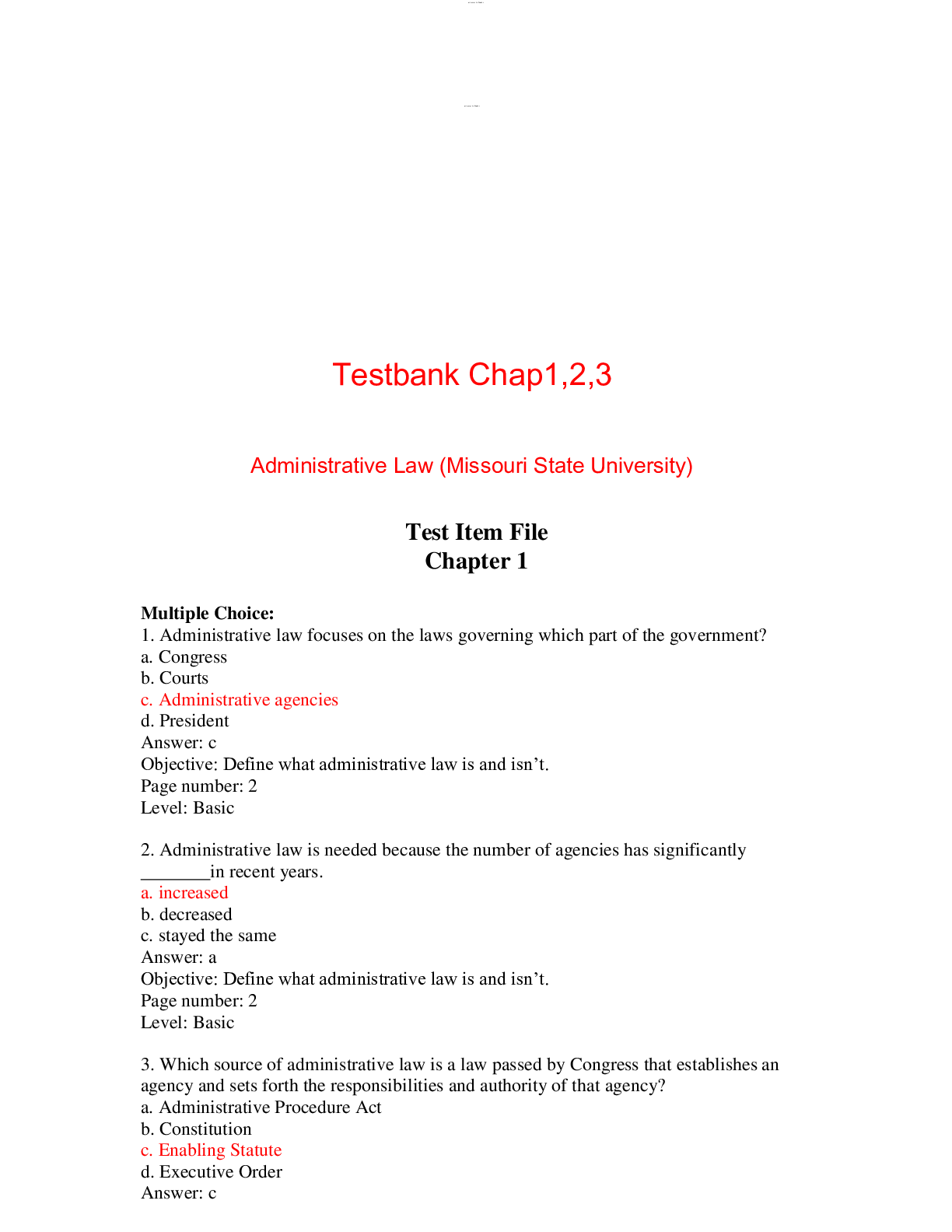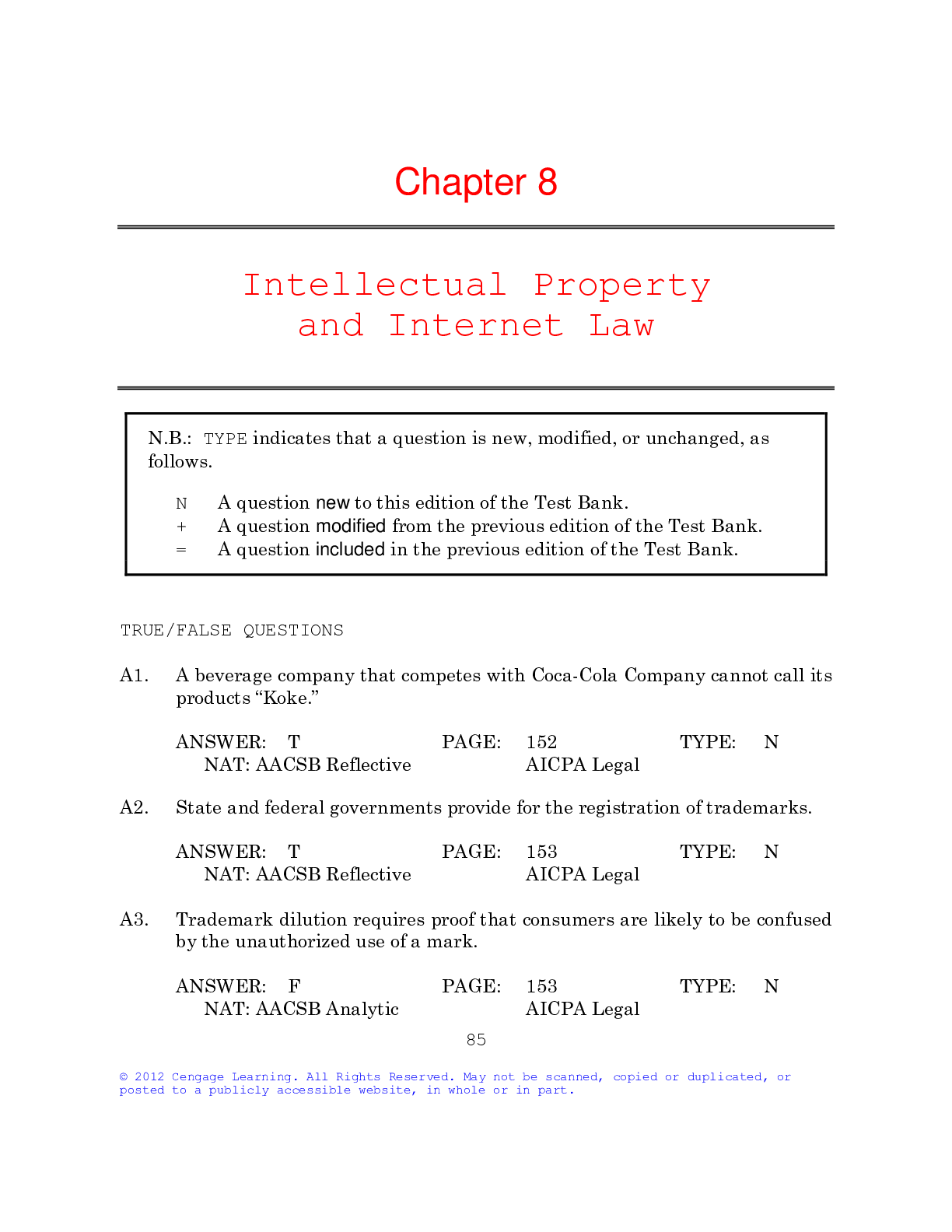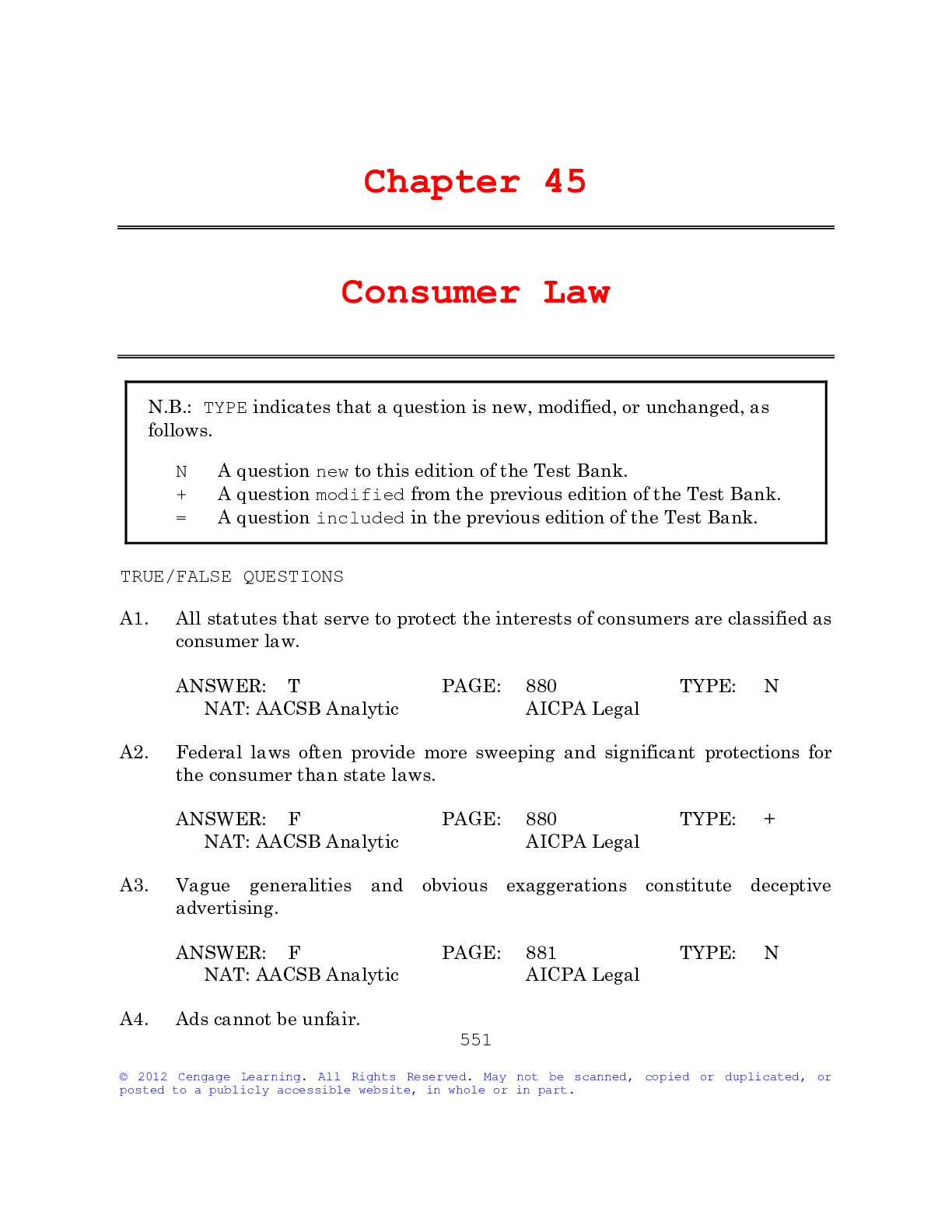Economics > QUESTIONS & ANSWERS > Chapter 44 Administrative Law. All Answers (All)
Chapter 44 Administrative Law. All Answers
Document Content and Description Below
N.B.: TYPE indicates that a question is new, modified, or unchanged, as follows. N A question new to this edition of the Test Bank. + A question modified from the previous edition of the Test Ban... k. = A question included in the previous edition of the Test Bank. TRUE/FALSE QUESTIONS A1. Like statutory law, administrative law is created by legislatures. F PAGE: 860 TYPE: N NAT: AACSB Analytic AICPA Legal A2. State regulation, when not preempted, may cover many of the same activities as federal regulation. T PAGE: 860 TYPE: N NAT: AACSB Analytic AICPA Legal A3. Federal administrative agencies can regulate beyond the powers granted by enabling legislation. F PAGE: 861 TYPE: N NAT: AACSB Analytic AICPA Legal A4. Federal executive agencies are outside the federal executive departments. F PAGE: 861 TYPE: N NAT: AACSB Analytic AICPA Legal A5. Administrative agencies can not make legislative rules, or substantive rules, that are as legally binding as laws that the Congress passes. F PAGE: 863 TYPE: N NAT: AACSB Analytic AICPA Critical Thinking A6. A court will not review an administrative agency’s decision until the case is “ripe for review.” T PAGE: 864 TYPE: N NAT: AACSB Analytic AICPA Legal A7. A party can challenge an administrative regulation as so irrational as to be arbitrary and capricious. T PAGE: 864 TYPE: N NAT: AACSB Analytic AICPA Legal A8. Rulemaking—the formulation of new administrative regulations—is a major function of Congress, not administrative agencies. F PAGE: 866 TYPE: N NAT: AACSB Analytic AICPA Legal A9. Final administrative rules have binding legal effect unless the courts later overturn them. T PAGE: 867 TYPE: N NAT: AACSB Analytic AICPA Legal A10. The period for persons to comment on a proposed administrative rule must be at least thirty days. T PAGE: 867 TYPE: N NAT: AACSB Analytic AICPA Legal A11. If the meaning of a statute’s language is unclear and an agency interprets it, a court must overturn the interpretation. F PAGE: 868 TYPE: N NAT: AACSB Analytic AICPA Legal A12. Informal agency actions are exempt from the Administrative Procedure Act’s requirements. T PAGE: 868 TYPE: N NAT: AACSB Analytic AICPA Legal A13. Many agency rules require compliance reporting from regulated entities, and such a report can not trigger an enforcement investigation. F PAGE: 870 TYPE: N NAT: AACSB Analytic AICPA Legal A14. There are no limits to the information that an administrative agency can demand from an individual or organization. F PAGE: 871 TYPE: N NAT: AACSB Analytic AICPA Legal A15. In most instances, an agency is not required to obtain a search warrant before a physical search for evidence is conducted. F PAGE: 872 TYPE: N NAT: AACSB Analytic AICPA Legal A16. If an investigation reveals a suspected violation of an administrative rule, the agency can not issue a formal complaint against the suspected violator. F PAGE: 872 TYPE: N NAT: AACSB Analytic AICPA Legal A17. Frequently, disputes over violations of administrative rules are resolved through informal adjudication proceedings. T PAGE: 873 TYPE: N NAT: AACSB Analytic AICPA Legal A18. The federal government must disclose certain records to any person or entity on written request only if there is a rational reason for the request. F PAGE: 874 TYPE: N NAT: AACSB Analytic AICPA Legal A19. Every portion of every meeting of a federal administrative agency does not have to be open to public observation. F PAGE: 875 TYPE: N NAT: AACSB Analytic AICPA Legal A20. An agency must conduct a regulatory flexibility analysis whenever a new regulation will have an impact on a “small number of substantial entities.” F PAGE: 876 TYPE: N NAT: AACSB Analytic AICPA Legal MULTIPLE CHOICE QUESTIONS A1. Boxy’s Packaging Materials Company is subject to regulations issued by the Occupational Safety and Health Administration (OSHA). Like other federal administrative agencies, the OSHA was created by a. Congress, through enabling legislation. b. the Federal Trade Commission, through the rulemaking process. c. the president, through an executive order. d. the U.S. Department of Labor, through a final order. A PAGE: 861 TYPE: = NAT: AACSB Reflective AICPA Legal A2. Independent regulatory agencies such as the Federal Trade Commission are a. not part of the government’s executive branch. b. outside the major departments of the government’s executive branch. c. subagencies of executive agencies. d. subject to more executive authority than executive agencies. B PAGE: 861 TYPE: = NAT: AACSB Reflective AICPA Legal A3. Executive control over the Federal Communications Commission, and other agencies, may be exercised through a pres¬iden¬tial veto of a. Congress’s modifications of the agency’s authority. b. the agency’s final rules. c. the agency’s final orders. d. none of the choices. A PAGE: 863 TYPE: = NAT: AACSB Analytic AICPA Legal A4. Pure Water Company is subject to a decision by the Environmental Protection Agency. Pure Water appeals the decision, arguing that it is arbitrary and capricious. This could mean that the decision a. changed the agency’s prior policy without justification. b. followed a consideration of all relevant factors. c. was accompanied by a rational explanation. d. was plainly warranted by the evidence. A PAGE: 864 TYPE: = NAT: AACSB Reflective AICPA Legal A5. The Federal Aviation Administration uses notice-and-comment rulemak¬ing. The final rule in such a proceeding has binding legal effect a. after a court affirms it. b. until the next presidential election. c. once Congress approves it. d. unless a court overturns it. D PAGE: 867 TYPE: N NAT: AACSB Analytic AICPA Legal A6. The Securities and Exchange Commission decides to create a new rule relating to the dissemination of material nonpublic information through corporate blogs, tweets, and Web sites. The first step is to a. compile the rule with others in the Code of Federal Regulations. b. conduct an on-site inspection. c. publish a notice of the proposed rulemaking. d. solicit public comment. C PAGE: 867 TYPE: = NAT: AACSB Reflective AICPA Legal A7. Before adopting new regulations to govern Internet-based phone services, the Federal Communications Commission may not a. hold hearings to acquire facts pertinent to the proposed rules. b. ignore the Administrative Procedure Act to streamline proceedings. c. order manufacturers to provide certain documents. d. solicit testimony from interest groups and consumers. B PAGE: 867 TYPE: = NAT: AACSB Reflective AICPA Legal A8. The U.S. Fish and Wildlife Service uses notice-and-comment rulemak¬ing. This involves a period during which a. judges, legislators, and the president are asked about a proposed rule. b. potential violators of a proposed rule are notified and publicized. c. the administrators “notice” a problem and “comment” on it. d. the public is asked to comment on a proposed rule. D PAGE: 867 TYPE: = NAT: AACSB Reflective AICPA Legal A9. To notify the public of a proposed rule, the Food Safety and Inspection Service, like other federal agencies, publishes the proposal in a. the news media. b. a trade journal available to members of the industry. c. the Federal Register. d. an office memo that employees are free to take home. C PAGE: 867 TYPE: + NAT: AACSB Reflective AICPA Legal A10. The Federal Aviation Administration uses notice-and-comment rulemak¬ing. The final rule in such a proceeding is sometimes referred to as a. a legislative rule. b. an interpretive rule. c. an adjudicatory order. d. an executive edict. A PAGE: 867 TYPE: = NAT: AACSB Reflective AICPA Legal A11. The Merit Systems Protection Board issues a rule. Like other adminis¬tra¬tive agencies’ “legislative rules,” this rule is as a. binding as a law passed by Congress. b. persuasive as an expert’s opinion. c. suggestive as a newspaper’s editorial. d. unenforceable as a salesperson’s puffery. A PAGE: 867 TYPE: = NAT: AACSB Reflective AICPA Legal A12. After notice-and-comment rulemaking, the U.S. Bureau of Land Management (BLM) issues a new rule and applies it to Clearcut Timber Company. Clearcut appeals the application to a federal court. The court will most likely defer to the BLM’s interpretation of a. the facts and the law. b. the agency’s authority. c. procedural requirements. d. the Constitution. A PAGE: 868 TYPE: + NAT: AACSB Reflective AICPA Legal A13. The Federal Trade Commission (FTC) orders GR8 Steaks Company to reveal certain information. GR8 Steaks complains to a court, arguing that the order is an abuse of the FTC’s discretion. Like other agencies, the FTC can use a subpoena to a. compel a party to testify, but not to obtain documents. b. obtain any information except what a party refuses to reveal. c. pressure a party to settle an unrelated matter. d. reveal violations of the law. D PAGE: 871 TYPE: = NAT: AACSB Reflective AICPA Legal A14. The Consumer Product Safety Commission (CPSC) wants Monster Toy Company to produce certain records for review. To obtain the records, the CPSC will issue a. an order for specific performance. b. a rule for parol evidence. c. a formal complaint. d. a subpoena. D PAGE: 871 TYPE: + NAT: AACSB Reflective AICPA Legal A15. The Internal Revenue Service (IRS) wants to seize certain documents of Mortgage Bank, Inc. Deciding whether it is permissible for the IRS to request or seize the documents depends on whether the docu¬ments are a. incriminating. b. relevant. c. technical. d. valuable. B PAGE: 871 TYPE: = NAT: AACSB Reflective AICPA Legal A16. The Food and Drug Administration (FDA) is investigating reports that Caplets Pharmaceutical Corporation is putting potentially harmful ad¬di-tives in Doze, a new pain-relief medication. The FDA’s demands for particular documents from Caplets a. must be specific and adequately describe the material being sought. b. must be non-specific so an incriminating item is not overlooked. c. must be general so as to force an uncooperative party’s compliance. d. may, but need not, be specific because the FDA is a federal agency. C PAGE: 871 TYPE: + NAT: AACSB Reflective AICPA Legal A17. The Nuclear Regulatory Commission (NRC) files a complaint against General Construction Corporation (GCC). GCC may want to set¬tle the dispute, before formal adjudicatory proceedings be¬gin, to avoid a. appearing uncooperative. b. eliminating the need for additional proceedings. c. rectifying the problem to the NRC’s satisfaction. d. saving the expense of formal proceedings and later appeals. A PAGE: 872 TYPE: = NAT: AACSB Reflective AICPA Risk Analysis A18. Guard Personnel Company is charged hiring practices that do not meet requirements set by the Transportation Safety Administration (TSA). The administra¬tive law judge or¬ders Guard to comply with the TSA’s regulations. Guard may a. appeal to the commission that governs the TSA. b. appeal to Congress, which created the TSA. c. appeal to a different, separate agency. d. ignore the order. A PAGE: 873 TYPE: = NAT: AACSB Reflective AICPA Legal A19. With some exceptions, every portion of every meeting of the Federal Reserve System Board of Governors and other federal administrative agencies must be open to public observation under a. no federal or state law. b. the Freedom of Information Act. c. the Government-in-the-Sunshine Act. d. the Public Accountability Act. C PAGE: 875 TYPE: = NAT: AACSB Analytic AICPA Legal A20. The Regulatory Flexibility Act has helped reduce record-keeping bur¬dens for Hometown Gas Company and other small business firms in the area of a. accounting practices. b. asset acquisition. c. hazardous waste management. d. tax reporting. C PAGE: 875 TYPE: = NAT: AACSB Reflective AICPA Critical Thinking ESSAY QUESTIONS A1. Administrative agencies—like the Securities and Exchange Commission, the Federal Trade Commission, and the Food and Drug Administration—make rules. What are the two basic types of rules called, and how bind¬ing are they? What must an administrative rule NOT do? A2. Grapple Market Share Corporation would like to know what information federal agencies have about Grapple’s operations, so that the firm will know what its competitors may be able to learn about it. Can Grapple require the agencies to dis¬close whatever informa¬tion they may have concerning it? If so, how should the firm make its request? What federal law applies? Is any information exempt? [Show More]
Last updated: 1 year ago
Preview 1 out of 18 pages

Buy this document to get the full access instantly
Instant Download Access after purchase
Add to cartInstant download
We Accept:

Reviews( 0 )
$7.00
Document information
Connected school, study & course
About the document
Uploaded On
Jan 03, 2020
Number of pages
18
Written in
Additional information
This document has been written for:
Uploaded
Jan 03, 2020
Downloads
0
Views
118




















